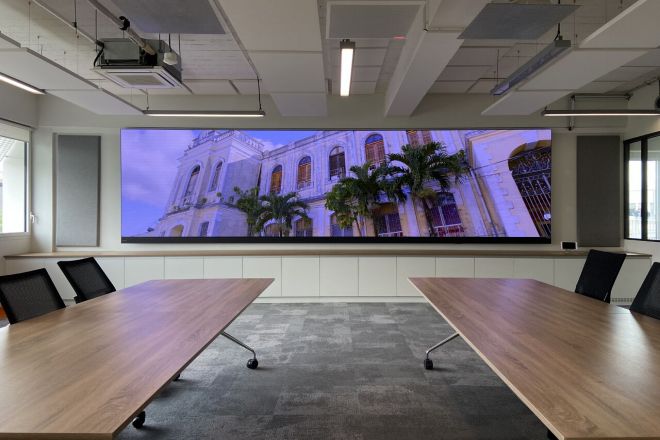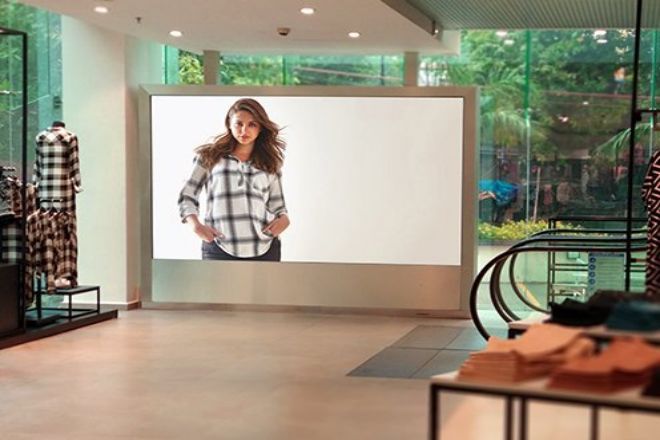介绍

踏入数字化时代的洪流, LED显示屏 犹如璀璨的星光,照亮我们的前途,但也伴随着一些迷雾和误解。
你有没有想过,那些闪耀在夜空中的巨屏广告,是否真的如传闻中的“耗电老虎”一样耗电?又或者,LED的画质,真的比不上高端电视屏幕?
本文就是一场揭秘之旅,我们将直击LED显示屏的五大常见误解,用事实和数据为你拨开迷雾,让你对这项技术有全新的认识。
跟随我们的脚步,让我们一起揭开LED显示屏的神秘面纱,探索它如何凭借非凡的性能和广泛的应用,为我们的生活带来前所未有的视觉盛宴和无限的可能性。你准备好了吗?让我们一起出发,开启这场知识与视觉的双重盛宴吧!
误区一:LED显示屏耗电量大、不环保

1). 误解解释
社会上存在一个误解,认为LED显示屏具有高亮度、大面积显示的特点,一定是高耗能产品,不利于环保。
这种观念或许是因为对LED技术的特点及其能源效率缺乏了解。
2). 真相
2.1).LED(发光二极管)技术的节能原理:
- 低工作电压:
LED是一种能直接将电能转化为光能的半导体器件。
其工作电压远低于白炽灯或荧光灯等传统照明设备,这意味着在相同亮度下,LED消耗的电能更少。
- 发光效率高:
LED的发光效率(即发光效率)远高于传统光源。
现代LED显示屏的发光效率已达到或超过了100流明/瓦,这意味着LED在产生同样的光通量时所消耗的电能更少。
- 可调节的 亮度:
LED显示屏通常都具有亮度调节功能,可以根据环境光或者实际需要来调节亮度,进一步节省能源。
例如在夜晚或者光线昏暗的室内环境中,可以适当降低LED显示屏的亮度,以减少能耗。
2.2). 数据支持
根据多项研究及实际应用案例,LED显示屏在节能方面表现优异,例如与传统投影技术相比,相同亮度下LED显示屏可降低能耗30%-50%。
与LCD(液晶显示器)、PDP(等离子显示器)等传统平板显示技术相比,LED显示屏的能耗优势更加明显,尤其在大尺寸、高分辨率的应用场景。
3).LED显示屏的环保优势
可回收性:LED显示屏主要材料包括LED芯片、电路板、外壳等,大部分材料都具有良好的可回收性。随着环保意识的提高和回收技术的进步,LED显示屏的处理将更加环保和可持续。
无汞、无铅设计:LED光源不含汞、铅等有害物质,减少了生产和使用过程中对环境和人体的潜在危害,相比之下,荧光灯等传统照明设备往往含有这些有害物质。
减少温室气体排放:由于LED显示屏具有明显的节能优势,在使用过程中可以大幅减少能源消耗和温室气体排放,这对于缓解全球气候变暖、实现低碳经济和可持续发展具有重要意义。
误区二:LED显示屏分辨率低,画质差

1). 误解解释
一些人认为,由于相对较大 像素间距 LED显示屏,特别是在传统大屏幕应用领域中,很难达到高清甚至超高清的显示效果,从而认为其画质较差。
2). 技术分析
2.1). 小间距LED与Micro LED技术:
随着技术的不断进步,LED显示屏行业推出了多种新技术来应对像素间距大、分辨率低的问题。
其中小间距LED(如P2、P1.5等)和Micro LED技术尤为引人注目,这些技术通过大幅缩小LED芯片的封装尺寸和像素间距,实现更高的分辨率和更精细的显示效果。
小间距LED像素间距可以达到毫米级,甚至亚毫米级,而Micro LED则将像素间距推向微米级,让超高清显示成为可能。
3). 应用实例
- 高端会议:
在高端商务会议中,高分辨率LED显示屏广泛应用于背景墙、主屏等场景,显示清晰的PPT、视频等内容,提升会议的专业性与观赏性。
- 电影放映:
随着技术的成熟,LED显示屏也开始进入电影放映领域。解决 LED电影屏可以提供更加细腻逼真的画面效果,给观众带来身临其境的观影体验。
- 虚拟现实:
在虚拟现实(VR)、增强现实(AR)等新兴领域,高分辨率LED显示屏也发挥着重要作用,能够模拟更加真实、立体的环境场景,为用户提供更加身临其境的体验。
4). 提升图像质量
- 色彩管理:
先进的色彩管理技术可以保证LED显示屏呈现更加准确、鲜艳的色彩,通过精细的色彩校准和色彩还原算法,使LED显示屏的色彩表现更加接近自然光下的真实色彩。
- 灰度控制:
灰度控制是提高LED显示屏画质的关键技术之一,通过优化灰度处理算法,提升灰度等级,可以使LED显示屏在显示低亮度图像时更加细腻、均匀,减少颗粒感和噪点。
误区三:LED显示屏易受环境因素影响,稳定性差

1). 误解解释
社会上存在担心,户外LED显示屏在面对高温、低温、潮湿、大风等恶劣气候环境时,其性能和稳定性会受到严重影响,甚至容易出现故障。
2). 防护技术
为了应对各种恶劣的环境挑战,LED显示屏行业制定了一系列高效的防护措施:
防水防尘:采用特殊的密封结构和材料,保证显示屏内部不会受到雨水、灰尘等外界因素的侵入,不仅保护了显示屏的电路和元器件,还延长了显示屏的使用寿命。
防紫外线:在显示屏表面涂抹防紫外线涂层或使用特殊材料,能有效阻隔紫外线对显示屏的损害,保持色彩的鲜艳度和亮度的稳定性。
耐腐蚀:对于海边、化工厂等强腐蚀环境中使用的显示器,采用耐腐蚀材料和涂层,防止金属部件生锈、电路板腐蚀。
防护等级高:IP65、IP67等防护等级标准代表显示屏对固体异物和水的防护能力,防护等级高的显示屏在户外恶劣环境下也能稳定运行。
3). 智能调节
除了物理防护措施外,现代LED显示屏还配备了智能调节系统,以进一步适应不同的环境条件:
智能温控系统:通过内置温度传感器以及风扇、散热器等散热装置,实时监控并调节显示器内部的温度,确保在高温环境下不会因过热而损坏。
自动亮度调节:根据环境光的变化,自动调节显示屏的亮度,既保证了显示效果,又避免了强光下耗电过大、弱光下刺眼。
误区四:LED显示屏维护成本高、更换困难
1).LED显示屏维护成本
- 设备成本和模块化设计
LED显示屏通常由多个模块组成,这种模块化设计使得单个模块发生故障时,只需更换故障的模块,而不用更换整个显示屏,大大降低了维护成本。
此外,随着LED技术的不断发展,LED显示屏价格逐渐下降,进一步降低了设备成本。
- 维护成本
定期维护是保证LED显示屏正常运行的关键。这包括清洁显示屏表面、检查连接线、更换老化部件等。虽然这些工作会产生一定的成本,但与更换整个显示屏的成本相比,这些维护成本相对较低。
在一些高端的应用场景中,还可以通过远程监控与故障诊断系统,实时监控显示屏的运行状态,及时发现和解决问题,进一步降低维护成本。
2).LED显示屏更换困难
- 模块化设计简化了更换过程
前面提到,LED显示屏的模块化设计让更换过程变得更加简单,当某个模块出现故障时,只需要将该模块从显示屏上拆下,再安装一个新的模块即可。
这种操作方法大大简化了更换流程,降低了更换难度。
- 专业技术支持
虽然LED显示屏的更换过程比较简单,但在实际操作中仍然需要一定的专业知识和技能。
因此在进行更换工作的时候,建议由专业的技术人员进行操作,以保证更换过程的顺利进行和显示屏的正常运行。
3). 不同场景的维护方法
- 室内场景
在室内场景下,LED显示屏主要受温度、湿度等环境因素的影响,因此需要定期检查显示屏的通风散热情况,保证显示屏处于合适的工作环境中。
同时,还要避免对显示器进行强烈的冲击或者刮擦,以防止显示器表面受损。
- 户外场景
在户外场景下,LED显示屏需要面对更加恶劣的自然环境,如风雨、日晒雨淋等,因此需要采取更加严格的维护措施。
其中包括定期检查显示屏的防水性能、防雷性能等,确保显示屏在恶劣天气下仍能正常运行。
另外,还需要定期对显示器表面进行清洁,以免灰尘、污垢堆积,影响显示效果。
误区五:LED显示屏只适合大规模应用,不适合小型场合

1). 误解解释
社会上存在一种偏见,认为LED显示屏体积较大、成本相对较高,主要适合户外广告、大型体育赛事等大型应用,并不适合在小型或者室内的场合使用。
2). 产品多元化
要打破这个误解,我们需要展现LED显示屏产品的多元化特点,事实上,LED显示屏已经发展出从微型到巨型的多种规格、多种系列,以满足不同场景和需求的应用:
微型LED显示屏:这种显示屏体积小、重量轻、易于携带,非常适合室内显示、桌面装饰或小型广告。
标准尺寸LED显示屏:适用于会议室等中型空间, 展览 大厅和零售店,既能提供足够的视觉冲击力,又不会占用太多空间。
巨型LED显示屏:当然,对于户外广告、体育赛事等大型活动来说,巨型LED显示屏依然是不可或缺的显示设备。
3). 室内应用
LED显示屏在室内场合的应用也十分广泛且富有创新:
会议室:高清LED显示屏可作为会议室的背景墙或主屏,显示PPT、视频等内容,提升会议的专业性和观赏性。
家庭影院:随着家庭娱乐需求的增长,LED显示屏也开始进入家庭影院领域,其出色的画质和色彩表现力能给观众带来更加震撼的观看体验。
零售商店:在零售商店中,LED显示屏可用于显示产品信息、促销活动等内容,以吸引顾客的注意力并增强购物体验。
4).个性化定制
LED显示屏除了产品规格多样以外,还可以根据客户的具体需求进行定制:
形状定制:根据安装环境或设计要求,LED显示屏可定制成圆形、弧形、异形等各种形状,以更好地融入周围环境或凸显设计特色。
尺寸定制:无论是小型的桌面显示,还是大型的墙面安装,LED显示屏都可以根据客户的具体尺寸要求进行定制。
分辨率定制:为了满足不同应用场景的画质要求,LED显示屏的分辨率也可以定制,高分辨率的显示屏可以提供更加细腻、清晰的画面效果。
结论
回顾全文,我们不难发现,LED显示屏并非人们想象的那么“高不可攀”或“完美无缺”,它有其独特的优势和亮点,也面临着不断的技术挑战和创新需求。
通过本文的分析与探讨,希望能够让大众更加全面、客观、深入地了解LED显示屏的视角,促进该技术的健康发展与广泛应用。
最后,如果你想了解更多关于LED显示屏的信息, 请与我们联系。
